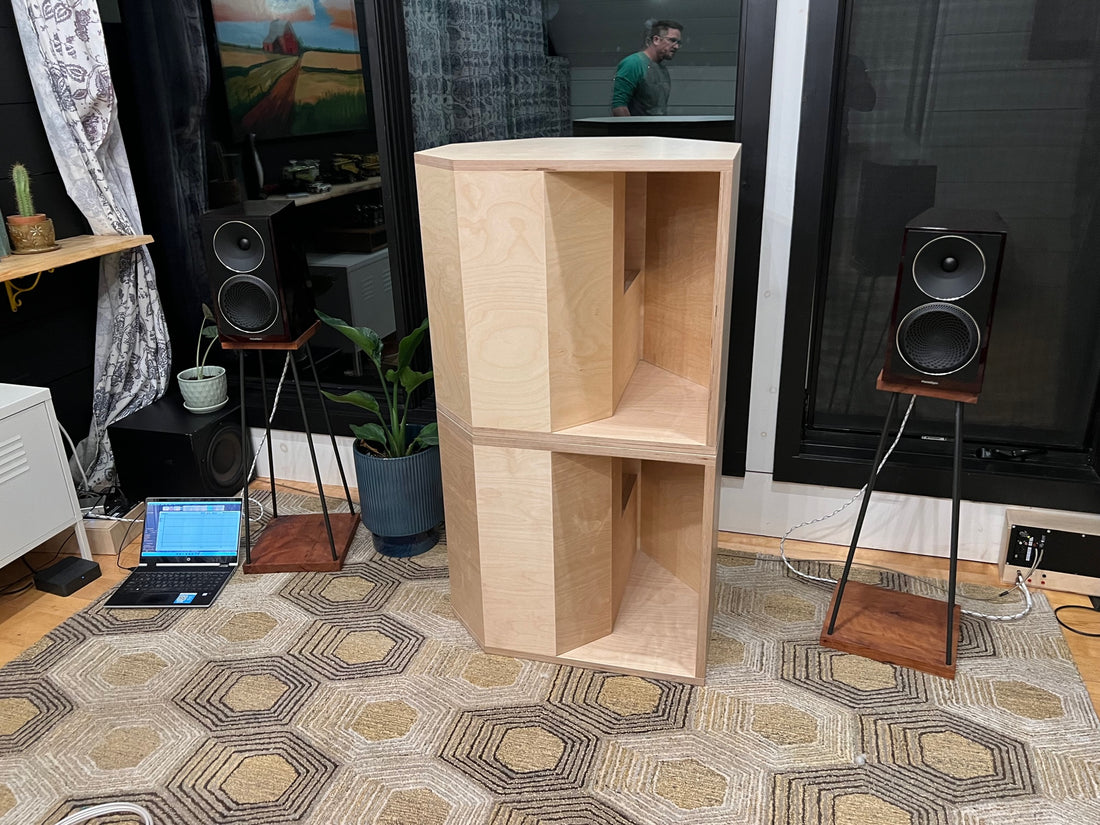Bass horn No.2420 is a new design that I've come up with which features a spiral ES horn path to reproduce bass frequencies from 30Hz-100Hz with a rated sensitivity of 105dB@1w (2.0v) at 1m anechoic.



The design is intended to be double stacked to allow for bass extension to 30Hz through mutual coupling. The driver was chosen for it's low QTS at only 0.19.
The B&C 15DS115 is a substantial subwoofer and simulates very well in the Hornresp software.


The design uses my ES spiral curvature to provide the horn path which is 4.8 meters long.



Features
- 24mm thick baltic birch plywood
- 75cm wide x 60cm deep x 127cm tall (63.5cm per cabinet)
- Utilizes x1 B&C 15DS115 per cabinet
Specification
- 30Hz-100Hz bandwidth (can go higher if needed)
- 105dB sensitivity (anechoic) or 109dB (in-room), parallel wiring at 2.0v input
Measurements
I began by measuring the response at the horn mouth using a 30cm mic distance. I've overlaid the impedance as well reference.
The impedances spikes at 32Hz, 75Hz, and 140Hz.

The hornresp simulation does not correlate to my results. Perhaps the woofer is not within specification and needs to be broken in. I've encountered this with other B&C woofers where the FS was too high "out of the box".

Below is the same result with 1/3 octave smoothing.

This corresponds to the hornresp simulation.


Below is the simulation

Below is the 1.0pi quarter space result (black) with the 2.0pi half space (grey).

Time Domain
Below is the burst decay waterfall result.

Below is the same result but shown as a sonogram. Below 100Hz there is little stored energy or resonances.

Distortion
I measured distortion with the mic placed on the ground at 1m. I tested at 85dB, 95dB, 105dB, & 115dB. I measured the input voltage for the specific test levels. The 95dB test signal level required only 0.83V which is a fraction of a watt.
Distortion remains below 1% even at the 105dB test signal.



Intermodulation Distortion
The next test used a multitone test signal ranging from 85dB, 95dB, and 105dB.
IMD is unchanged at -55dB for the 85dB, 95dB, and 105dB test signal.
Its likely a good sign that IMD does not increase at all regardless of the test SPL.



Subjective Listening Impression
Early listening tests was conducted at my brothers upstairs listening room. We used his newly acquired Paradigm stand-mount speakers power by the Hypex FA253 plate amp which was fed by the Wiim Pro via digital signal.
We used a steep low pass filter centered at 100Hz essentially creating a sub-satellite setup. The stand mount speakers were high pass filtered preventing reproduction of bass frequencies.
Bass was similar to what I heard with speaker system No.2095 where there was palpable nuance and subtleness to the bass. Bass quality is some of the best I've heard.
As we moved about the room we found deep bass at the back of the listening room. I took a frequency response measurement at this location which is shown below. There are plenty of room modes happening but we see bass extension to 30Hz.

Conclusion
Bass cabinet No.2420 achieves its design target for low distortion and high sensitivity. Subjectively the sound quality is up there with the best I've heard, providing excellent dynamics and transient attack.
It was curious to compare the bass character between the Paradigm stand mount versus the bass cabinet. The bass from the Paradigm was gentle and soft, more heard than felt. The bass cabinets provided a much more entertaining and engaging bass, raising the enjoyment factor by quite a bit.
Even with the 4.8m horn path length I did not detect any delay artifacts in relation to the stand mount speakers. I am suspicious that the new B&C subwoofers will need to be broken in in order for them to setting into their operating point published and predicted in hornresp. As it stands I believe low bass may be a little light as a result of the subwoofer's fundamental resonance (FS parameter) being a little too high in the frequency range.
We then tried separating the cabinets and listening to them as a stereo pair.

This configuration offered excellent bass quality as well. We couldn't help but wonder what double stacked as a stereo pair would sound like. It seems this would be optimal for projecting a massive soundstage image and bass feel.
Cone Velocity Comparison
The cone velocity for the 2420 bass cabinet at 95dB SPL 1m is only 10.3 mm/s. If we compare this to a 15" bass reflex enclosure for the same SPL then it jumps up to 20.7mm/s. This is what I beleive contributes to the faster bass sensation.
Additionally, the voltage difference between 2420 and a bass reflex (for the same SPL) is .83V compared to 1.75V.
Stay tuned for more testing and experimentation.
